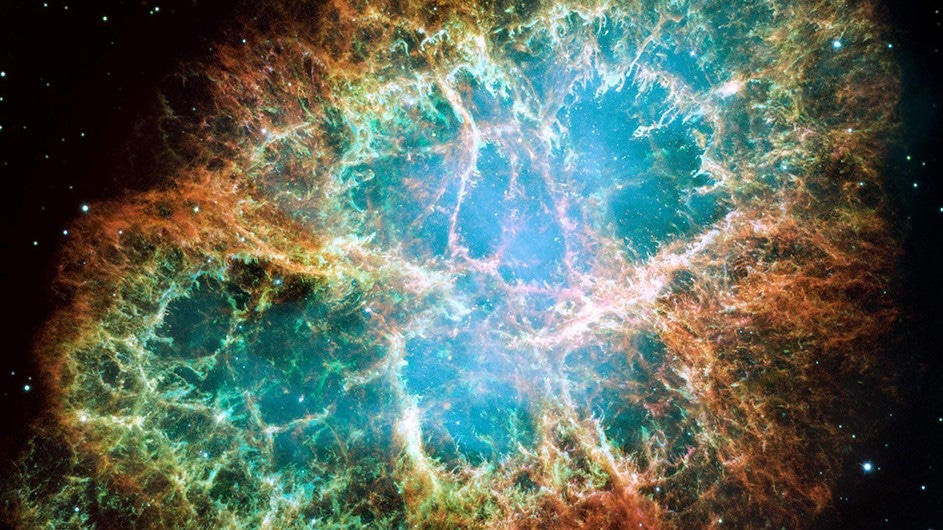Nov 28 2019
For several years, researchers have contemplated about the source of the electromagnetic radiation discharged from celestial regions that host neutron stars and black holes—the most enigmatic objects in the universe.
 The rapidly spinning neutron star embedded in the center of the Crab nebula is the dynamo powering the nebula’s eerie interior bluish glow. The blue light comes from electrons whirling at nearly the speed of light around magnetic field lines from the neutron star. The neutron star, the crushed ultra-dense core of the exploded star, like a lighthouse, ejects twin beams of radiation that appear to pulse 30 times a second. Image Credit: NASA, ESA, J. Hester (Arizona State University)
The rapidly spinning neutron star embedded in the center of the Crab nebula is the dynamo powering the nebula’s eerie interior bluish glow. The blue light comes from electrons whirling at nearly the speed of light around magnetic field lines from the neutron star. The neutron star, the crushed ultra-dense core of the exploded star, like a lighthouse, ejects twin beams of radiation that appear to pulse 30 times a second. Image Credit: NASA, ESA, J. Hester (Arizona State University)
Astrophysicists are certain that this high-energy radiation, which causes black holes and neutron stars shine bright, is produced by electrons that move at approximately the speed of light, but the process that speeds up these particles has remained elusive.
Recently, scientists at Columbia University have put forth a new explanation for the physics behind the speeding up of these energetic particles.
Astrophysicists Luca Comisso and Lorenzo Sironi used massive super-computer simulations to quantify the mechanisms that speed up these particles. They determined that their energization is the outcome of the interaction between chaotic motion and reconnection of super-strong magnetic fields. Details of their work have been published in the December issue of The Astrophysical Journal.
Turbulence and magnetic reconnection—a process in which magnetic field lines tear and rapidly reconnect—conspire together to accelerate particles, boosting them to velocities that approach the speed of light. The region that hosts black holes and neutron stars is permeated by an extremely hot gas of charged particles, and the magnetic field lines dragged by the chaotic motions of the gas, drive vigorous magnetic reconnection.
Luca Comisso, Study First Author and Postdoctoral Research Scientist, Columbia University
Comisso added, “It is thanks to the electric field induced by reconnection and turbulence that particles are accelerated to the most extreme energies, much higher than in the most powerful accelerators on Earth, like the Large Hadron Collider at CERN.”
When analyzing turbulent gas, researchers cannot forecast chaotic motion exactly. Handling the mathematics of turbulence is hard, and it accounts for one of the seven “Millennium Prize” mathematical problems.
To confront this challenge from an astrophysical standpoint, Comisso and Sironi designed wide-ranging super-computer simulations—among the world’s largest-ever performed in this research area—to solve the equations that define the turbulence in a gas of charged particles.
We used the most precise technique—the particle-in-cell method—for calculating the trajectories of hundreds of billions of charged particles that self-consistently dictate the electromagnetic fields. And it is this electromagnetic field that tells them how to move.
Lorenzo Sironi, Study Principal Investigator and Assistant Professor of Astronomy, Columbia University
According to Sironi, the vital point of the study was to pinpoint the role magnetic reconnection plays within the turbulent environment. The simulations revealed that reconnection is the significant mechanism that chooses the particles that will be accelerated by the turbulent magnetic fields.
They also showed that particles obtained most of their energy by bouncing randomly at a very high speed. When the magnetic field is powerful, this acceleration mechanism is very fast. But the strong fields also push the particles to move in a curved path, and by doing so, they discharge electromagnetic radiation.
“This is indeed the radiation emitted around black holes and neutron stars that make them shine, a phenomenon we can observe on Earth,” Sironi said.
The ultimate aim, according to the scientists, is to learn what exactly is going on in the extreme environment near neutron stars and black holes, which could shed more light on fundamental physics and enhance one’s understanding of how the universe functions.
They propose to connect their study even more resolutely by comparing their predictions with the electromagnetic spectrum discharged from the Crab Nebula, the most extensively studied bright remnant of a supernova (a star that violently burst in the year 1054).
We figured out an important connection between turbulence and magnetic reconnection for accelerating particles, but there is still so much work to be done. Advances in this field of research are rarely the contribution of a handful of scientists, but they are the result of a large collaborative effort.
Luca Comisso, Study First Author and Postdoctoral Research Scientist, Columbia University
According to Comisso, other scientists, such as the Plasma Astrophysics group at the University of Colorado Boulder, are making crucial contributions in this direction.